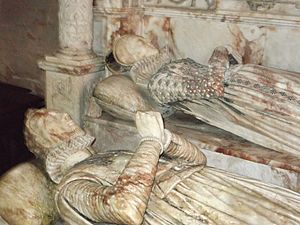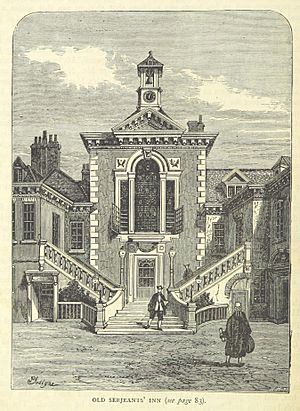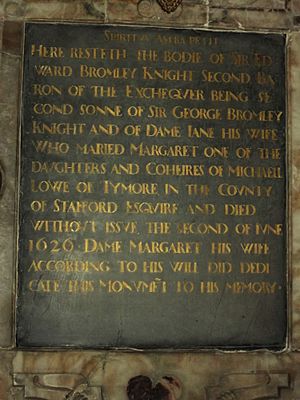Edward Bromley facts for kids
Sir Edward Bromley (1563–1626) was an important English lawyer, judge, and politician. He lived during the reigns of Queen Elizabeth I and King James I. Sir Edward came from a well-known family in Shropshire, a county in England. Many of his family members were also lawyers and landowners.
He was a key member of the Inner Temple, which is one of the four main legal schools in London where lawyers are trained. Later, he became a judge called a Baron of the Exchequer. He was also elected to represent the town of Bridgnorth in Parliament six times in a row.
Contents
Early Life and Family Background
Edward Bromley was the second son of Sir George Bromley and Joan Waverton. His father, Sir George, was a significant lawyer at the Inner Temple. He also held important political jobs, like being the chief legal officer for the Council in the Marches of Wales. This council helped govern parts of England and Wales.
Edward's uncle, Thomas Bromley, was even more famous. He became the Lord Chancellor, one of the highest legal positions in England. Edward's mother, Joan, came from the Waverton family, who owned a place called Hallon near Worfield. Sir George made Hallon the family home after marrying Joan.
Edward had an older brother named Francis, who was supposed to inherit the family lands. He also had two younger brothers and three sisters. His sisters married into other powerful families in the region. At that time, wealthy landowners, known as the gentry, had a lot of power in Shropshire.
Education and Legal Training
Edward Bromley started school at Shrewsbury School in 1577 when he was about 14 years old. This school focused on Christian values and learning, and it encouraged students to be confident.
In 1580, Edward joined the Inner Temple, a famous law school in London. He was allowed to join for free because of his father's high status. He became a barrister, a type of lawyer who can argue cases in court, in 1590. He shared a room at the Inner Temple with Michael Lowe, a chief clerk from the King's Bench court. This close connection led to Edward marrying Michael Lowe's daughter, Margaret, in 1593.
Edward became very important at the Inner Temple. In 1603, he was made a "bencher," a senior member who helps run the Inn. He was given more responsibilities, like helping with important dinners and checking accounts. In 1605, he was chosen to be the "Lent Reader," a high academic honor where he would teach other lawyers. After this, his career moved towards becoming a judge.
Parliamentary Career
Edward Bromley was elected as a Member of Parliament (MP) for Bridgnorth six times. He served in every Parliament from 1586 to 1604. Bridgnorth was a small town, and its MPs were usually chosen by local leaders and powerful families. Edward, being a local landowner and a lawyer, easily won these elections. His father was also a very important person in the Bridgnorth area.
In the early parliaments, Edward usually took the first of the two seats for Bridgnorth. He didn't make a big impact in the House of Commons during Queen Elizabeth I's reign.
Parliament Under King James I
In 1604, Edward was elected to the first Parliament under King James I. This Parliament lasted for a long time, until 1611. Edward was not as active as some other MPs, but he did some important work.
He was asked to discuss the king's idea of joining Scotland and England into one kingdom. He also helped draft a bill to stop "outlaws" (people who broke the law or refused to follow the Church of England) from being in Parliament. This was a response to a dispute between the king and Parliament over who could be an MP.
Edward also chaired a committee that helped restore the good name of John Lyttelton. John Lyttelton had been accused of treason and died in prison. This was important to Edward because John Lyttelton's mother, Meriel Bromley, was Edward's cousin.
In February 1610, Edward had to leave Parliament because he was appointed as a judge.
Continued Political Influence
Even after leaving Parliament, Edward Bromley remained influential in towns like Bridgnorth and Much Wenlock, where he later became a "recorder" (a type of judge). He helped his nephew, Thomas Wolryche, get elected as an MP for Much Wenlock in 1621, 1624, and 1625.
Judicial Career
Edward Bromley's career as a judge began very quickly. In February 1610, he was made a "Serjeant-at-law," which was a special rank for top barristers. This was done specifically so he could become a judge. He was one of only two people to receive this honor during King James I's reign for the purpose of becoming a judge.
The very next day, February 6, 1610, Edward was appointed a Baron of the Exchequer. This meant he became a judge in the Exchequer of Pleas court, which handled important legal cases, especially those about fairness. He was the third person in his family to become a judge. When he went to court for the first time as a judge, many members of the Inner Temple walked with him in a procession. A few weeks later, on February 26, he was knighted by the king.
Sir Edward Bromley served as a Baron of the Exchequer until he died. He also worked as a "justice of assize," which meant he traveled to different parts of the country to hear cases. He worked on the Northern circuit until 1618, then moved to the Midland circuit. He also became a recorder for towns in his home county of Shropshire, including Much Wenlock, Shrewsbury, and Bridgnorth.
Landowner
As a second son, Edward Bromley didn't expect to inherit a lot of land. He lived in a smaller family property called Shifnal Grange. When his father died in 1589, the main family lands went to his older brother, Francis. However, Francis died less than two years later, and the lands passed to his young son, Thomas.
Meanwhile, Edward started to build his own landholdings. In 1593, he married Margaret Lowe, who inherited some land near Enville in Staffordshire. From then on, he took on local roles that landowners often held. By 1595, he was a Justice of the Peace for Shropshire, helping to keep order. After the Gunpowder Plot in 1605, he was part of a group that investigated the lands of the people involved in the plot. These roles often brought him some income as well as responsibility.
Just two weeks after Edward became a Baron of the Exchequer, his nephew Thomas died. This meant Edward became the heir to the main Bromley family lands. However, there was a dispute over some of the lands, especially Hallon, which had come from Edward's mother. His niece, Jane, and her husband, William Davenport, also claimed these lands. This argument over Hallon lasted for many years, and eventually, the Davenport family took control of it.
Death
Sir Edward Bromley died on June 2, 1626. He was buried in St Peter's church at Worfield. In his will, he asked for a quiet burial without much ceremony. He also left money for a monument to be built for him.
His wife, Lady Margaret Bromley, had a beautiful alabaster tomb built for him at Worfield. The inscription on his tomb says: "Spiritus astra petit," which means "The spirit strives for the stars." It also mentions that he died without children and that his wife dedicated the monument to his memory.
Edward's family lands automatically went to his younger brother, George. Edward left gifts to his godchildren and servants. He had hoped his wife would use his possessions during her lifetime, but because of the land dispute over Hallon, he changed his will at the last minute. He gave all his personal property to his wife to make up for any losses she might have.
He chose his three sisters, his brother-in-law, and his friends, judges John Denham and Sir Richard Hutton, to oversee his will. He also left small amounts of money for the poor people in several towns, including Worfield, Bridgnorth, and Shifnal.
Marriage and Family
Edward Bromley married Margaret Lowe on March 18, 1593. She was the daughter of Nicholas Lowe. They did not have any children together.
Edward had close relationships with his godchildren, who were the children of his sisters. He also stayed close to his cousins, the Bromleys of Worcestershire. He even helped some of his nephews and cousins get admitted to the Inner Temple, hoping to adopt one of them as his heir. However, the one he hoped to adopt, Philip Bromley, died before him.
Lady Margaret Bromley, Edward's wife, lived for more than 30 years after he died. She was buried in 1657 in Loughborough. Her will was very simple, asking for a quiet funeral. She was known for being a very religious person and supported a Presbyterian minister named Oliver Brumskill.
Images for kids






